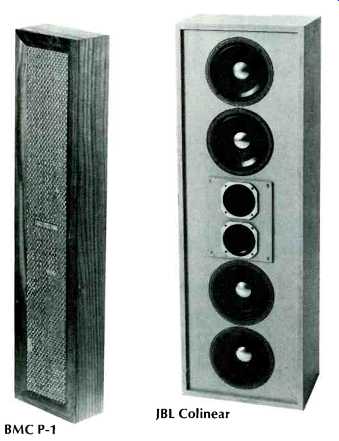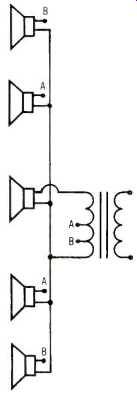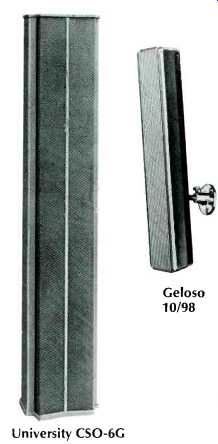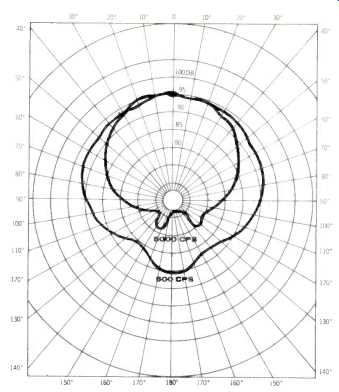
BMC P-1; JBL Colinear

Fig. 1--Showing one method of power 'tapering.'
The BMC model P-1 column at the far left has an array of six 4M-inch speakers fitted with dispersion domes. Response is said to extend down to 40 Hz and the dimensions are 33 1/2 by 8 1/2 by 5 inches wide. Model P-2 is a smaller version measuring 29% inches high with a reduced bass response. JBL's 4380 is called a ‘Colinear' array and it uses four 8-inch speakers with two 5 inch high-frequency units. Horizontal radiation is 120 deg. and 20 deg. vertical. The University CSO-6G 'Uniline' is completely weatherproof and constructed to withstand severe environmental conditions. It uses six 8-inch speakers and the two middle units have `whizzer' cones to increase h.f. response. Dimensions are 6032 by 11 by 7% deep and the frequency response is given as 65 Hz to 14 kHz. The small system is a Geloso model 10T/98 which employs three 5-inch speakers. The ball-type swivel permits a wide range of adjustment and among the other features is a variable thumb-type impedance selector. This `mini-column' is ideal for low-level background music or paging systems. Dimensions are 1933 by 4 by 3 inches deep. The large curved system is an Electro-Voice LR7 which has no less than nine 5 by 7-inch speakers plus two compression tweeters. Frequency range is 50 Hz to 17 kHz and dimensions are 60 1/2 by 11 by 14 inches deep.
Line-source, or sound-column systems consist of several speakers mounted vertically and spaced as close as possible in an enclosure. Such systems project the sound forward in a horizontal beam with minimum side and rear radiation. Reflections from walls and ceilings are reduced making for better intelligibility, and the sound pattern allows a greater latitude in microphone placement to avoid feedback. Usual lengths are 4 to 7 feet which to some extent determines the low-frequency response in accordance with the' following formula:
1= [720/f_1 sin_theta] ft
Where fi lowest working frequency
θ angle a which intensity is -6 dB at f1
In order to maintain a uniform high-frequency response, i.e. to prevent undue beaming effects, it is customary to tailor the response of the units or use series inductors for the top and bottom units.
To arrive at the required wave shape with a minimum of side-lobes, input should be distributed with full power applied to the middle units and tapered off at each end. This is usually accomplished by using taps on the input transformer as shown in Fig. 1. In outdoor systems where reflections from walls do not reinforce the sound, it is worth remembering that doubling the distance from speaker to listener reduces the sound pressure by 6 dB. To make this up, amplifier power would have to be increased by a factor of four.


University CSO-6G; Geloso 10/98; Electro-Voice LR7
At the upper left of the page is the Jensen TXC-56 system which uses six 5 1/4-inch speakers. Frequency response is quoted as 100 Hz to 10 kHz, and the dimensions are 40.5 by 9.5 by 5.5 inches deep. Model TXC-84 is similar in styling, but is fitted with four 8-inch units, and the frequency response is extended down to 50 Hz and up to 15 kHz. Dimensions are 52.5 by 13.25 by 7% inches deep. At the right is the Electro-Voice LR4SA, which is described as an all-weather line radiator. It comprises six 5by-7-inch speakers, and the frequency response is given as 200 Hz to 10 kHz. Dispersion is 120 deg. horizontal and 30 deg. vertical.

Fig. 2-Horizontal dispersion of Bozak system.
The enclosure--which is made from extruded aluminum--is 48.5 by 6.25 by 4 inches deep. At the left is a Bozak CM-200-10 mounted on a pole. This system is intended for areas with severe reverberation problems and the bass response rolls off below 200 Hz. It comprises two 6-inch speakers with eight 2-inch treble units. The polar diagram shown in Fig. 2 is the horizontal dispersion pattern at 500 Hz and 5 kHz. Model CM-109-18 is a larger system with a low-frequency response going down below 100 Hz, and it uses six 8-inch speakers plus twelve 2-inch treble units. It is somewhat larger, measuring 57 by 15% by 10 inches deep.

Jensen TXC-56; Bozak CM-200-10; Electro-Voice LR4SA

Fig. 3--Method of slot-loading.
The diagram of Fig. 3 is that of a slot-loaded enclosure as used by Bozak. These are very popular in Europe and are used extensively for airport installations. Care has to be used in design to avoid cavity effects. The majority of enclosures are sealed, but reflex loading with narrow ports is sometimes used in the larger systems.
(Audio magazine, Aug. 1970)
Also see:
Another Look At Parallel-Connected Loudspeakers (Nov. 1970)
What Price Loudspeaker Response Curves (Mar. 1972)
Speaker Tests: Room Test by Richard C. Heyser (Jan. 1975)
Speaker Tests--Phase Response (by Richard C. Heyser) (Dec. 1974)
The Acoustic Feedback Loudspeaker System (Jan. 1972)
= = = =